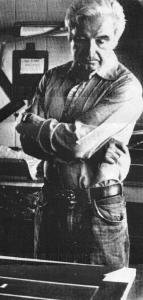FEATURE BY Alan Bodian
PROVINCETOWN, MA -- Nationally renowned cartoonist and longtime Provincetown resident, Mischa Richter, was born in Kharkov, the Ukraine, on Aug. 12, 1910. Aside from Czarist pomp and ceremony in the capital of St. Petersburg, Russia seemed a vast agrarian wasteland slow to enter the 20th century and reluctant to adapt to the Industrial Revolution during an era of dynamic change. Kharkov was a notable exception. A city of more than half a million with parks and museums, a technological institute, concert halls and a sophisticated school system, Mischa spent his first twelve years in this cosmopolitan city.
World War
I marked the end of the old order and the beginning of the new communist
regime. Russia, through protests, strikes and massive disruptions, became
the Soviet Union and revolution, not agriculture, became its main export.

Back on our own soil, John Reed, two years after helping found the Provincetown
Players, caught the fever and followed the revolution to the Soviet Union.
Reed brought with him his own brand of incendiary reporting. The result was his masterpiece, Ten Days That Shook the World, an eyewitness account of the events that crushed the Russian monarchy and marked the birth of the Soviet Union.
By the early twenties, warning signs sent shock waves through large segments of the Soviet population. The hopes and great experiments of 1917 were dimmed when Lenin died. Gone was the age of enlightenment and tolerance, gone was the early optimism of the Jewish population. Once Stalin came to power, the USSR was haunted by a resurgence of past repressions. A dark cloud hovered over the Revolution.
A time for decision! Citizens had to decide whether to stay and take their chances or leave and begin a new life elsewhere. For the Richters the choice became clear when relatives in America encouraged them to come to Boston. Leaving Kharkov was no simple matter, however. The Bolsheviks had installed a bureaucratiuc obstacle course making it difficult to obtain passports and visas. Bribing petty officials was part of the ritual and delays were commonplace. Micha's father devised a circuitous route by way of Poland where the family had to establish a residence before continuing on their journey. Late in 1922 the Richters arrived in Boston. For Mischa, then twelve, Boston was a serendipitous choice as he immediately showed talent as an artist, having profited from his lessons with a private tutor. For reasons best known to themselves, the Brahmin establishment sent certain sons of immigrants--gifted ones like Mischa--to the Boston Museum School.
In 1930, the Depression was well underway and Mischa wanted to enroll at Yale because of its prestigious art department. Money was tight but scholarships and loans from his father made it possible. The early thirties was an ideal time to enter that Gothic sanctuary of higher learning. While most of his generation was tightening its belt, Mischa moved to New Haven to begin his studies.
By 1934 he graduated from Yale and married the love of his life, Helen Sinclair Annand. Armed with a diploma and a young wife, he faced the grim prospect of being an artist in an era consumed by the spectre of mass unemployment.
Elected to the first of four terms in 1932, President Franklin D. Roosevelt came to the rescue with Federal programs to revive a moribund economy. It was a miraculous formula.
For many artists, Roosevelt's Works Projects Administration was their salvation and sole means of survival. Mischa was one of its many beneficiaries. In 1934, subsidized by the WPA, he painted a fifty-foot mural which was installed in the Burroughs Newsboy Foundation. The project attracted widespread attention and was hailed by critics as the first narrative mural in Boston.
Despite the Depression, Mischa was bursting with ideas at a time when ideas counted. The collision of freedom and fascism demanded commentary from the scalding wit of political cartoonists and Mischa became one of the best. Between 1937 and 1942 his work was in great demand from a wide range of publications as different as the Journal-American and The New Masses.
Though he always considered himself a serious artist, he embraced the reality that a single humorous drawing reached a huge audience. He also didn't mind the speed with which he was financially compensated. Painting was always speculative. A canvas, no matter how labored and masterful, might only be seen by a handful and was often consigned to the lonely silence of the studio.
One of the watershed moments of his career came in January, 1942 when The New Yorker offered him a contract for his cartoons--an offer that placed him in the company of such acclaimed artists as Thurber, Arno and Steig. Mischa had been on a roll. Between 1941-42, his work had made frequent appearances in PM, a liberal daily financed by Marshall Field of Chicago, and in 1945 King Features signed him to do a panel titled "Strictly Richter" which appeared in Hearst publications for sixteen years.
Among Richter's many talents was the ability to concentrate on the subject at hand, to give it total attention and focus. During the many years I knew him, what impressed me most was his ability to produce under the most stressful ciorcumstances, especially during the long period when his wife Helen was incapacitated by multiple sclerosis. During her illness his work schedule became flexible and he moved his studio to the dining room to be close at hand. Undaunted by interruptions (and there were many) it was during this period that he produced many of his most memorable New Yorker drawings.
His method was deceptively simple. First came an idea, sometimes visual or merely a gesture or a politician's pomposity. Hand and eye in close communion, he began a series of sketches and, by a process of additions, deletions and erasures, an image formed accompanied, of course, by a caption.
The rough sketch was picked up on Monday by Federal Express to reach the New Yorker editorial meeting on Tuesday. If accepted and OK'd, it would be returned on Friday.
Perfectionist that he was, Mischa went upstairs to his studio to put the final touches on the completed drawing. For him humor was a deadly serious business and he was never completely satisfied with the final version. There were decisions and revisions made until the elventh hour. I remember many early morning phone calls about the wording of a caption, "Was it vernacular? Was the grammar correct?" he used to ask. "Is it really funny?" His strongly graphic signature, like an exclamation point, meant he signed off on the work, that he was happy with it.
Mischa never referred to his work as cartoons but rather as "magazine art." Lee Lorenz, in his introduction to The Art of the New Yorker, 1925-1995, called Mischa and other celebrated contributors "great comic illustrators." Lorenz said that among his colleagues, Mischa was admired for his wit, intellectual curiosity, draftmanship and prolific output.
During the 58 years his work appeared in The New Yorker, 1500 drawings were published, 26 per year or an average of one every two weeks. The line was always firm, draftmanship impeccable, the wit always finding its mark.
The final one to appear, about a year before he died, was consistent with his mordant commentary on the human condition. The scne: an elderly couple in a funeral parlor. The woman presses her ear against a closed coffin. The man says, "It must be his beeper."
In the world of publishing Mischa's humor was much admired and frequently reproduced in volumes covering a wide range of subjects. He was commissioned to write books of his own, among which were Arthur's World, published by Doubleday in 1967, and Quack?, Harper & Row, 1976. The latter, a huge success, was translated into several languages, including Japanese. It gave Mischa enormous pleasure to know that his off-the-wall humor proved relevant to a culture far removed from his own.
Throughout his life Mischa continued to paint in oils and acrylics with occasional detours into collage. In 1997, the Cape Museum of Fine Art hosted a one-man show featuring a series of his paintings dealing with the homeless. The Provincetown Arts Association held a retrospective honoring his life's work.
Though he spoke with a deep and abiding affection for Italy, especially Taormina, Provincetown was the place Mischa most wanted to live. In the early 50s, he and his wife settled here permanently.
Ever since his first visit, while a student at Yale, Mischa felt Provincetown had everything he ever wanted. His home on the water (a stone's throw from the old Flagship restaurant) afforded privacy and incredible light, a stunning view of the Truro hills and provided this avid swimmer with a beach at his doorstep. He lived just a short stroll from The Beachcomber where he shared the companionship of fellow artists on Saturday nights.
A proud and private man, Mischa remained at the top of his form often saying with a touch of octogenarian irony that he wanted "to die healthy." He continued to paint and think of ideas for The New Yorker until the very end.
Mischa Richter, one of Provincetown's beloved icons, died on March 27, 2001 at the age of ninety.
